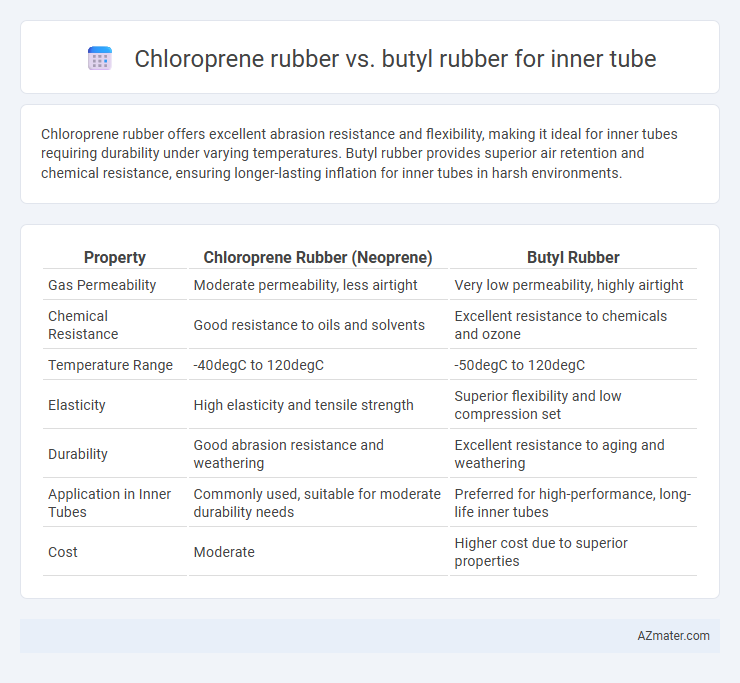Chloroprene rubber offers excellent abrasion resistance and flexibility, making it ideal for inner tubes requiring durability under varying temperatures. Butyl rubber provides superior air retention and chemical resistance, ensuring longer-lasting inflation for inner tubes in harsh environments.
Table of Comparison
| Property | Chloroprene Rubber (Neoprene) | Butyl Rubber |
|---|---|---|
| Gas Permeability | Moderate permeability, less airtight | Very low permeability, highly airtight |
| Chemical Resistance | Good resistance to oils and solvents | Excellent resistance to chemicals and ozone |
| Temperature Range | -40degC to 120degC | -50degC to 120degC |
| Elasticity | High elasticity and tensile strength | Superior flexibility and low compression set |
| Durability | Good abrasion resistance and weathering | Excellent resistance to aging and weathering |
| Application in Inner Tubes | Commonly used, suitable for moderate durability needs | Preferred for high-performance, long-life inner tubes |
| Cost | Moderate | Higher cost due to superior properties |
Introduction to Inner Tube Materials
Chloroprene rubber and butyl rubber are prominent materials used for inner tubes due to their distinct properties. Chloroprene rubber offers excellent resistance to abrasion, ozone, and heat, making it suitable for high-performance tires requiring durability and flexibility. Butyl rubber excels in air retention and impermeability, providing superior airtightness and resistance to gas permeation, which is critical for maintaining tire pressure over time.
Overview of Chloroprene Rubber
Chloroprene rubber, also known as neoprene, offers excellent abrasion resistance, good flexibility at low temperatures, and superior resistance to oils and chemicals, making it suitable for inner tubes exposed to harsh environments. Compared to butyl rubber, chloroprene provides enhanced durability and better performance under extreme conditions, though it is generally less airtight than butyl rubber. Its balanced elasticity and resilience ensure reliable inner tube performance in diverse applications, especially where chemical resistance is critical.
Overview of Butyl Rubber
Butyl rubber, a synthetic rubber primarily composed of isobutylene with a small amount of isoprene, offers exceptional air impermeability and excellent resistance to heat, chemicals, and weathering, making it an ideal material for inner tubes. Its low gas permeability significantly reduces air loss, which enhances the durability and performance of inner tubes compared to chloroprene rubber. Butyl rubber also exhibits superior flexibility and resilience under varying temperature conditions, contributing to longer inner tube lifespan and improved safety in tire applications.
Key Performance Differences
Chloroprene rubber offers superior abrasion resistance and good flexibility at low temperatures, making it durable for inner tubes exposed to varying road conditions. Butyl rubber excels in air impermeability and chemical resistance, providing excellent airtightness and longer retention of inflation in inner tubes. The choice between chloroprene and butyl rubber hinges on prioritizing either wear resistance or superior gas retention for optimal inner tube performance.
Air Retention Capabilities
Chloroprene rubber offers moderate air retention capabilities due to its balanced permeability and flexible molecular structure, making it suitable for inner tubes requiring resilience and moderate airtightness. Butyl rubber excels in air retention with its low gas permeability and high impermeability, providing superior performance in maintaining tire pressure for extended periods. The choice between these materials depends on prioritized air retention needs, with butyl rubber favored for longevity and Chloroprene for flexibility and chemical resistance.
Resistance to Temperature Extremes
Chloroprene rubber exhibits superior resistance to temperature extremes, maintaining flexibility and durability from -40degC to 120degC, making it ideal for inner tubes exposed to varying climates. Butyl rubber performs well at moderate temperatures but tends to harden below -30degC and soften above 100degC, which can compromise inner tube integrity under extreme conditions. Therefore, chloroprene rubber is preferable for inner tubes requiring consistent performance across a broader temperature range.
Durability and Longevity
Chloroprene rubber offers superior durability and resistance to ozone, weathering, and oils compared to Butyl rubber, making it highly effective for inner tubes used in demanding environments. Butyl rubber excels in air retention and flexibility but generally exhibits lower resistance to abrasion and chemical exposure, which can reduce its longevity under harsh conditions. For inner tubes requiring extended service life and robust performance, Chloroprene rubber typically outperforms Butyl rubber in durability and long-term reliability.
Cost Comparison
Chloroprene rubber typically costs more than butyl rubber due to its superior resistance to oils, weathering, and temperature extremes, making it a premium choice for inner tubes. Butyl rubber remains the more economical option, valued for its excellent air retention and durability at a lower price point. Manufacturers often choose butyl rubber for cost-effective inner tubes, while chloroprene rubber suits high-performance applications despite its higher cost.
Applications and Industry Preferences
Chloroprene rubber is favored in inner tube applications requiring high resistance to oils, weathering, and ozone, making it popular in automotive and industrial tire manufacturing. Butyl rubber excels in air retention and impermeability, which leads to its extensive use in inner tubes for bicycles, motorcycles, and specialty tires where long-term inflation stability is critical. Industry preferences lean towards chloroprene for durability in harsh environments, while butyl rubber dominates markets prioritizing airtightness and flexibility.
Conclusion: Choosing the Right Rubber for Inner Tubes
Chloroprene rubber offers excellent resistance to oils, weather, and ozone, making it suitable for high-performance inner tubes requiring durability and flexibility under varying conditions. Butyl rubber excels in airtightness and chemical inertness, providing superior air retention and stability, ideal for standard inner tubes where longevity and resistance to gas permeability are crucial. Selecting the right rubber depends on prioritizing performance needs: chloroprene for enhanced environmental resistance and flexibility, butyl for optimal air retention and chemical stability.

Infographic: Chloroprene rubber vs Butyl rubber for Inner tube
 azmater.com
azmater.com